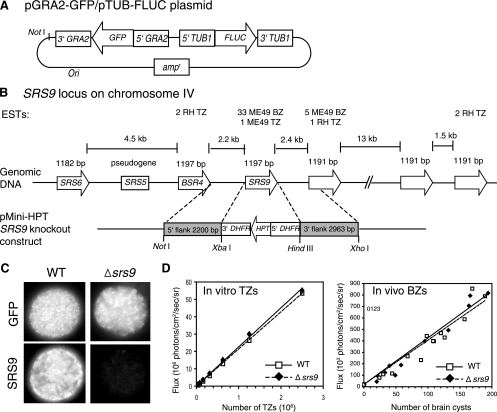FIG. 1.
Generation of a bioluminescent Toxoplasma PruΔsrs9 strain. (A) Depiction of the pGRA2-GFP/pTUB1-FLUC plasmid used to create the bioluminescent PruΔhpt strain without using any drug selection. The map is not drawn to scale. (B) Depiction of the SRS9 locus on Toxoplasma chromosome IV. Six closely related, intron-free genes and one pseudogene are tandemly located as a cluster. The map is not drawn to scale. The number of expressed sequence tags (ESTs) known for each gene is shown (http://www.toxodb.org/toxo-release4-0/home.jsp). Double-homologous recombination between the SRS9 knockout construct and genomic sequence replaces SRS9 with HPT, which was used for positive selection. TZ, tachyzoites. (C) Immunofluorescence assays confirming the lack of SRS9 protein expression by Δsrs9 parasites derived from the PruΔhpt/GFP/FLUC strain. Brain cysts from chronically infected CBA/J mice were stained with a rabbit polyclonal anti-SRS9 antiserum. (D) FLUC activity comparison between WT and Δsrs9 strains. Various numbers of tachyzoites released from human fibroblasts in culture were plated in a black 96-well plate (twofold serial dilutions starting from 2 × 106 tachyzoites), and photon flux was detected by using the IVIS100 imaging system. For bradyzoites (BZ), brain homogenates from WT- or Δsrs9 parasite-infected CBA/J mice (6 weeks after i.p. infection with 500 tachyzoites) were plated in a black 96-well plate. GFP+ cysts were counted in each well, and photon flux was determined by BLI after addition of luciferin. There is no significant difference in brain cyst sizes between WT and Δsrs9 strains (see Fig. 3B). Photon flux from tachyzoites and brain cysts from a parasite strain lacking the FLUC gene was equal to that of culture medium alone (data not shown). Lines within graphs represent linear regression correlation.

